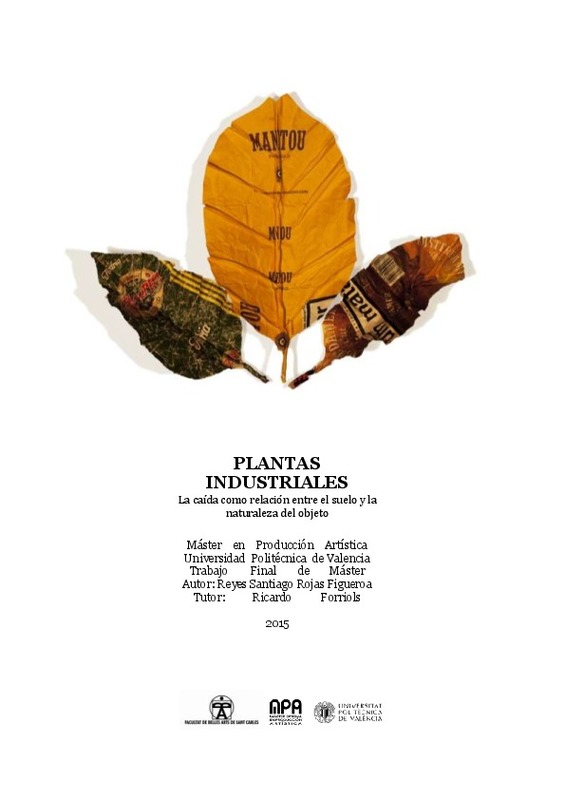JavaScript is disabled for your browser. Some features of this site may not work without it.
Buscar en RiuNet
Listar
Mi cuenta
Estadísticas
Ayuda RiuNet
Admin. UPV
Plantas industriales: la caída como relación entre el suelo y la naturaleza del objeto
Mostrar el registro sencillo del ítem
Ficheros en el ítem
| dc.contributor.advisor | Forriols González, Ricardo Javier
|
es_ES |
| dc.contributor.author | Rojas Figueroa, Reyes Santiago
|
es_ES |
| dc.date.accessioned | 2016-02-12T13:43:07Z | |
| dc.date.available | 2016-02-12T13:43:07Z | |
| dc.date.created | 2015-09 | |
| dc.date.issued | 2016-02-12 | |
| dc.identifier.uri | http://hdl.handle.net/10251/60832 | |
| dc.description.abstract | The things that fall on the ground are signs of the constant use and throw away, characteristics of a consumer society. To analyse these objects and deduce from them what they are made of, allow us to identify the plants they are composed of: tobacco packages, beer cans, packets of sugar, coins of minimum value, plastic caps for all kinds of liquids and containers for drinks with artificial flavours. Tobacco, sugar cane, barley and rubber are some of the plant species that where introduced from America to Europe. Since colonial administration processes and the renaming of nature, to a current international market, where these species circulate as merchandise. The reciprocal relations with the contemporary nature are the symbiosis between the natural and the artificial. It is the diversity of parts that compose a contemporary landscape, showing a path of natural and political history of a timeless nature to a cultural chronology. From these reflections, I present the following theoretical research practice which result in a series of assemblages, objects and drawings made with those parts of the everyday landscape where the collection, the archiving and reopening of the archives of the objects is used as a material to return to the appearance of industrialized plant. | es_ES |
| dc.description.abstract | Sobre el suelo cosas caídas advierten una señal de usar y botar, característico de una sociedad de consumo. Analizar estos objetos y deducir en ellos de que están hechos, permite identificar las especies de plantas del intercambio entre América y Europa. Desde procesos coloniales en la administración y renombramiento de la naturaleza, hasta un actual mercado internacional, donde estas especies circulan como mercancía empaquetada en envoltorios de tabaco, latas de cerveza, sobres de azúcar, monedas de mínima denominación, tapones plásticos para toda clase de líquidos, y envases de bebidas aromatizadas con sabores artificiales. Las relaciones recíprocas con la naturaleza contemporánea son la simbiosis entre lo natural con lo artificial, la diversidad de partes que componen un paisaje contemporáneo, evidenciando la trayectoria de la historia natural y política de una naturaleza atemporal a una cronología cultural. A partir de estas reflexiones, presento la siguiente investigación teórico practica, en la cual, resultan una serie de ensamblajes, registros fotográficos, objetos y dibujos hechos con esas partes de un paisaje cotidiano, donde la recolección, el archivo y desarchivo de objetos se usan como material para retornar a la apariencia de la planta industrializada. | es_ES |
| dc.format.extent | 95 | es_ES |
| dc.language | Español | es_ES |
| dc.publisher | Universitat Politècnica de València | es_ES |
| dc.rights | Reserva de todos los derechos | es_ES |
| dc.subject | Registros fotográficos | es_ES |
| dc.subject | Paisaje cultural | es_ES |
| dc.subject | Naturaleza artificial | es_ES |
| dc.subject | Plantas industriales | es_ES |
| dc.subject | Residuos | es_ES |
| dc.subject.classification | HISTORIA DEL ARTE | es_ES |
| dc.subject.other | Máster Universitario en Producción Artística-Màster Universitari en Producció Artística | es_ES |
| dc.title | Plantas industriales: la caída como relación entre el suelo y la naturaleza del objeto | es_ES |
| dc.type | Tesis de máster | es_ES |
| dc.rights.accessRights | Abierto | es_ES |
| dc.contributor.affiliation | Universitat Politècnica de València. Facultad de Bellas Artes - Facultat de Belles Arts | es_ES |
| dc.contributor.affiliation | Universitat Politècnica de València. Departamento de Comunicación Audiovisual, Documentación e Historia del Arte - Departament de Comunicació Audiovisual, Documentació i Història de l'Art | es_ES |
| dc.description.bibliographicCitation | Rojas Figueroa, RS. (2015). Plantas industriales: la caída como relación entre el suelo y la naturaleza del objeto. http://hdl.handle.net/10251/60832. | es_ES |
| dc.description.accrualMethod | Archivo delegado | es_ES |
Este ítem aparece en la(s) siguiente(s) colección(ones)
-
BBAA - Trabajos académicos [5086]
Facultad de Bellas Artes






